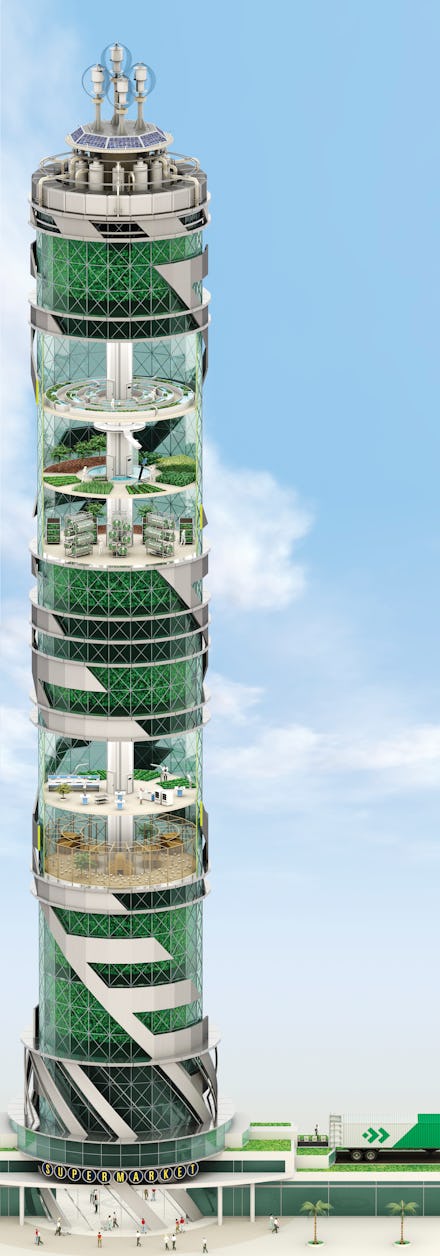Thanks to These Dutch Engineers, We May Soon Be Getting Our Food From Skyscrapers

By 2050, the world might find itself in a critical food shortage. It's a scary thought, but one group is developing a clever way to combat that with a plan they claim can grow enough fresh produce to feed the world in a space one-third the size of Hawaii.
To make this happen, PlantLab, a Dutch agriculture firm, wants to construct "plant production units," spaces made for growing plants and vegetables. Each unit is customizable, able to adjust and control anything from to the amount and kind of light received, a major value for photosynthesis, to how large the space needs to be — anything from a garden the size of a microwave to a skyscraper.
By either constructing buildings, or, potentially more sustainably, retrofitting existing, unused buildings, PlantLab believes they can construct spaces where plants will grow faster and more efficiently.
This means the entirety of California's almond-growing operation could be put into something the size of a Best Western hotel, while also cutting out pesticides, producing three to five times more almonds and using 90% less water thanks to smarter hydration — all without tweaking the almond's genetics.
The firm estimates it takes one square meter of farming to produce enough fruits and vegetables for a single person. So, doing some quick math, to accomplish their goal of feeding Earth's 9 billion residents, we would need roughly 3,474 square miles, or a space roughly one-third the size of the state of Hawaii. So, pretty small, considering how many people that will feed.
Fixing major problems: More often than not, crop yields can dramatically rise or fall based on the amount of moisture they get. In a traditional field, plants are under all types of sunlight, including ones that stifle growth.
To address this, PlantLab's plants are under almost exclusively infrared light, which doesn't need to be supplemented by as much water. By studying individual crop-growing profiles called Plant IDs, researchers can determine the most efficient way to make crops grow quickly and abundantly — what it calls Plant Paradise. Because different plants require different amounts of water and light, this kind of data and analysis allows the perfect growing atmosphere to be created, while using only a fraction of the resources needed in a traditional farming environment.
Though Plant Paradise might sound like a gimmick to trick kids into buying desktop mint gardens, the concept provides a sustainable way to quickly and efficiently increase crop yields while avoiding the realm of genetically altered foods, which have their own mutated, possibly cancer-causing demons.
Though some have argued genetically modified organism foods may be the only way to feed the estimated 9.5 billion population in 2050, others maintain genetically altered foods could present more problems and ultimately harm global food security. However, with the promise of vertical gardening, it may not need to become a conversation.
Fixing the water problem: While it sounds a little radical, hyper-observed vertical farms may also be the answer to water shortages in places like China, Africa and the United States.
California, the largest producer of agriculture in the U.S., was issued its first mandatory water restriction order Thursday as a means of cutting 25% of use by the 400 water supply agencies in the Golden State. This comes after California Gov. Jerry Brown asked his constituents to voluntarily cut their water use by 20% in 2014. He even shut water off in Central Valley farm areas, creating a modern dust bowl — which made its cinema debut, if exaggerated, in 2014's Interstellar.
Considering most of the needed, uncompromisable water use in California is for farming, installing indoor farm skyscrapers could more than meet the 25% cut with room to spare.
This isn't a new phenomenon. At least not completely. Highrise farms have become increasingly likely to replace traditional big-field farms as a means of feeding the planet. In 2011, Japanese plant physiologist Shigeharu Shimamura turned an old Sony factory into a 25,000-square-foot indoor farm, partnering with General Electric to use LED lights for growing 10,000 heads of lettuce every day. This resulted in a system that was allegedly 100 times more productive than traditional means. And in general, urban skyscraper gardens have been in the conversation for most of this decade.
PlantLab isn't asking to turn the world's major metropolitan areas into some crazy Blade Runner landscape. It just suggests we take over old, unoccupied buildings to create urban farmland or farmland in areas where producing food is nearly impossible due to brutal living conditions. It could be the kind of technology that puts an arena of carrots in Morocco, or a football field of rhubarb in the middle of the Gobi Desert. With greatly reduced reliance on water and space, it's much easier to provide a lot to places with very little.